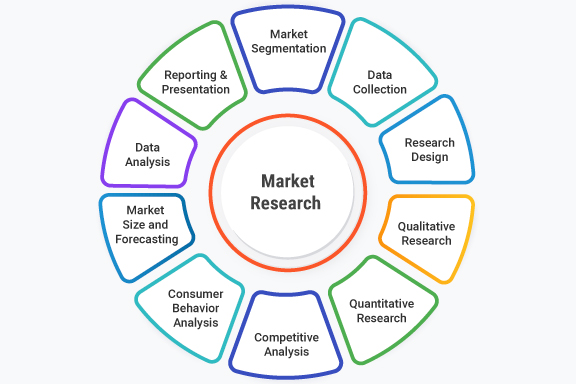Marketing research is a crucial component of any business strategy. It involves gathering, analyzing, and interpreting information about a market, its consumers, and competitors to make informed business decisions. There are various types of marketing research methodologies, each serving specific purposes and offering valuable insights. Let’s delve into the different types of marketing research to understand their significance in driving business success.
Introduction to The Types of Marketing Research

Marketing research serves as the foundation for strategic decision-making in businesses. It provides insights into consumer preferences, market trends, and competitive landscapes, enabling companies to tailor their strategies effectively.
Exploring Primary Marketing Research
Primary marketing research involves collecting data firsthand. It includes methods such as surveys, interviews, and focus groups.
– Surveys
Surveys are structured questionnaires designed to gather information from a sample of individuals. They provide quantitative data about consumer preferences, buying behaviors, and satisfaction levels.
– Interviews
Interviews involve direct conversations between researchers and participants to gather in-depth insights. They allow for probing questions and a deeper understanding of consumer attitudes and motivations.
– Focus Groups
Focus groups bring together a small group of individuals to discuss specific topics under the guidance of a moderator. They encourage open discussions and reveal collective opinions and perceptions.
Understanding Secondary Marketing Research
Secondary marketing research involves analyzing existing data and information collected by others. It includes sources such as market analyses, competitor reports, and industry publications.
– Market Analysis
Market analysis involves examining market trends, size, growth potential, and competitive dynamics. It helps businesses identify opportunities and threats within their target markets.
– Competitor Analysis
Competitor analysis entails studying competitors’ strategies, strengths, weaknesses, and market positioning. It enables businesses to benchmark their performance and develop competitive advantages.
– Industry Reports
Industry reports provide comprehensive insights into specific sectors, including market trends, regulatory changes, and emerging technologies. They help businesses stay informed about industry developments and make informed decisions.
Differentiating Qualitative and Quantitative Research
The types of marketing research can be qualitative or quantitative. Qualitative research focuses on understanding attitudes, behaviors, and motivations, while quantitative research involves numerical data and statistical analysis.
Exploring Exploratory Research
Exploratory research aims to explore new topics or phenomena and generate insights for further investigation. It helps businesses identify research questions and hypotheses for future studies.
Investigating Descriptive Research
Descriptive research seeks to describe characteristics, behaviors, or phenomena within a population. It provides a snapshot of current conditions and helps identify patterns or trends.
Understanding Causal Research
Causal research aims to establish cause-and-effect relationships between variables. It helps businesses understand how changes in one-factor influence outcomes and enables them to predict future trends.
Exploring the Importance of Market Segmentation
Market segmentation involves dividing a heterogeneous market into smaller, homogeneous segments based on shared characteristics or needs. It enables businesses to target specific customer groups with tailored marketing strategies.
Investigating Consumer Behavior Research
Consumer behavior research examines how individuals make purchasing decisions and interact with products and brands. It helps businesses understand consumer needs, preferences, and decision-making processes.
Exploring Product Research
Product research involves testing and evaluating new products or product features to determine their market viability and acceptance. It helps businesses identify potential improvements and innovations.
Understanding Pricing Research
Pricing research involves studying consumer perceptions, price sensitivity, and willingness to pay for products or services. It helps businesses optimize pricing strategies to maximize profitability and competitiveness.
Investigating Promotion Research
Promotion research evaluates the effectiveness of advertising, promotions, and marketing campaigns. It helps businesses allocate resources efficiently and enhance the impact of their promotional efforts.
Understanding Distribution Research
Distribution research examines distribution channels, logistics, and supply chain management practices. It helps businesses optimize distribution networks and improve inventory management.
Exploring International Marketing Research
International marketing research focuses on understanding cultural, economic, and regulatory differences across global markets. It helps businesses adapt their strategies to diverse environments and expand their international presence.
Conclusion
In conclusion, the types of marketing research play a pivotal role in guiding strategic decision-making and driving business growth. By leveraging various research methodologies, businesses can gain valuable insights into consumer behavior, market trends, and competitive landscapes, enabling them to stay agile and competitive in dynamic markets.
To experience the power of data-driven insights firsthand and unlock your business’s full potential, request a demo from AIM Technologies today!
FAQs
Why is marketing research important for businesses?
- Marketing research is crucial for businesses as it helps them understand their target market, consumer preferences, and industry trends. By conducting thorough research, businesses can make informed decisions, identify opportunities, mitigate risks, and stay ahead of competitors.
What are the key differences between primary and secondary marketing research?
- Primary marketing research involves collecting data firsthand from sources like surveys, interviews, and focus groups. Secondary marketing research, on the other hand, involves analyzing existing data and information collected by others. While primary research offers specific and tailored insights, secondary research provides broader industry trends and competitor analysis.
How does market segmentation contribute to effective marketing strategies?
- Market segmentation involves dividing a heterogeneous market into smaller, homogeneous segments based on shared characteristics or needs. By understanding the distinct preferences and behaviors of different consumer segments, businesses can tailor their marketing strategies, messages, and product offerings to effectively target and engage specific audience groups.
What role does consumer behavior research play in product development?
- Consumer behavior research is critical in product development as it helps businesses understand how consumers perceive, evaluate, and use products. By analyzing consumer preferences, purchasing habits, and feedback, businesses can identify opportunities for product improvement, innovation, and differentiation to meet evolving customer needs and preferences.
How can businesses leverage international marketing research to expand globally?
- International marketing research enables businesses to understand cultural, economic, and regulatory differences across global markets. By researching international consumers, competitors, and market trends, businesses can identify viable expansion opportunities, adapt their marketing strategies, localize their products or services, and mitigate risks associated with entering new markets.




